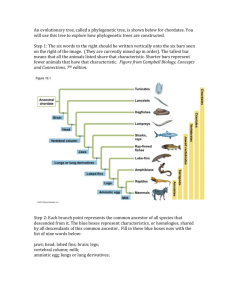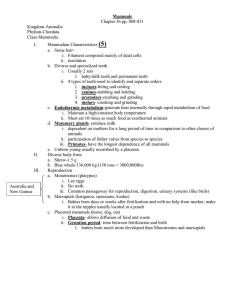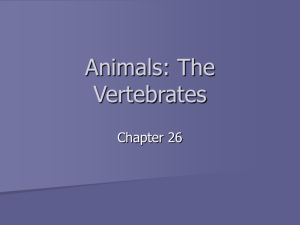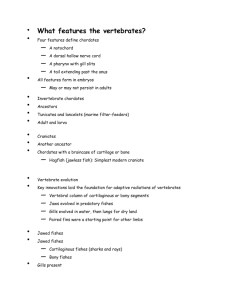Vertebrate Diversity I BIO 112 The Protochordates Subphylum Vertebrata
advertisement
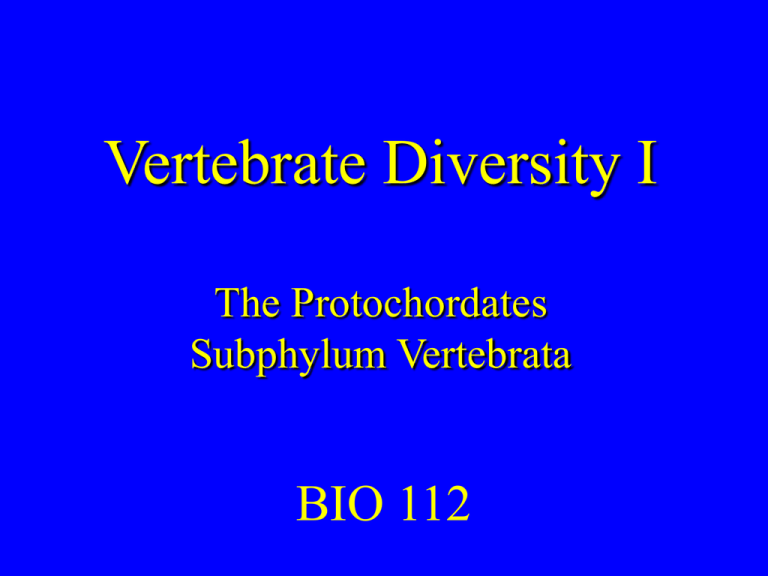
Vertebrate Diversity I The Protochordates Subphylum Vertebrata BIO 112 Q1: Deuterostomes 1) 2) 3) 4) Have radial, indeterminate cleavage Are ancestrally enterocoelous Develop the mouth as the second gut opening All of the above Deuterostomes and Chordates • Generic deuterostome characteristics: – Radial, indeterminate cleavage – Enterocoely – Deuterostomy • The four Chordate characteristics: – Notochord – Pharyngeal gill slits – Post-anal tail – Dorsal hollow nerve chord (+ trends toward segmentation and cephalization) The “Protochordates” • Ph. Hemichordata • Ph. Chordata – Subph. Urochordata – Subph. Cephalochordata Q2: The only chordate character retained by adult tunicates is the 1) 2) 3) 4) Notochord Pharyngeal gill slits Dorsal hollow nerve chord Post-anal tail Q3: The closest protochordate vertebrate ancestors are the 1) 2) 3) 4) Echinoderms Hemichordates Urochordates Cephalochordates Sub-ph. Vertebrata Central characteristics: • • • • segmented vertebral column (i.e., backbone) cranium (brain case: bone or cartilage) closed circulatory system neural crest cells – become teeth, part of cranium, adrenal glands • nephritic kidneys • semicircular vestibular canals • seconarily schizocoelous Sub-ph. Vertebrata Bases for classification (shared derived traits) : cranium and jaws lateral appendages consolidation of vertebrae cartilagenous vs. bony skeleton tetrapody and petadactyly anamniotic vs. amniotic egg endothermy vs. ectothermy scales, feathers, fur milk extended parental care Q4: Which of the following is NOT a distinguishing vertebrate character? 1) 2) 3) 4) Neural crest cells Nephritic kidneys Radial symmetry A segmented backbone Class (or Superclass) Agnatha • Jawless fishes – – – – circular mouths; specialized feeding notochord persists through life lack paired appendages single dorsal nostril • 2 extant taxa: – Myxini: hagfish – Cephalaspidomorphi: lamprey Ostracoderms: extinct agnathans The lamprey -- an ectoparasite Lamprey on prey Lamprey mouth -- yikes! Lamprey ammocoetes larva: (clear affinity with cephalochordates) A gravel-dwelling filter feeder when young Hagfish -- a scavenger This is why it’s called the “slime hag”! Q6: “Agnathans” derive their name from their lack of 1) 2) 3) 4) Paired nostrils Jaws Paired lateral appendages A segmented backbone Jaws or No Jaws? • Superclass Agnatha: – Cl. Myxini – Cl. Cephalaspidomorphi/ Petromyzontia • Superclass Gnathostomata – – – – – – Cl. Chondrichthyes Cl. Osteichthyes C. Amphibia Cl. Reptilia Cl. Mammalia Cl. Aves The Placoderms: first jawed fishes (now extinct) Evolution of Jaws from Gill Arches Cl. Chondrichthyes • Cartilaginous fishes: sharks, skates, rays – light-weight, elastic skeleton • • • • • Gills Paired fins (pectoral and pelvic fins) Large oily liver for buoyancy Heterocercal tail Scavengers or predators Sharks Heterocercal tail Shark jaws with choppers . . . If jaws evolved from gill arches, where did teeth come from? Denticles on shark skin Skates Manta Ray (or, “BayWatch meets the Chondrichthyes”) Cl. Osteichthyes • Bony fishes: about half of all vertebrates! • Gills with operculum: gill cover • Swim bladder for buoyancy – derived from outpocketing of pharynx • flexible pectoral fins – can provide propulsion (not in shark) Q6: The Osteichthyes differ from the major Chondrichthyes groups in having 1) 2) 3) 4) A swim bladder A bony skeleton Gill covers (opercula) All of the above Examples of bony fishes Fish with swim bladder 2 sub-classes of Bony fishes: • Sub-Cl. Actinopterygii • Sub-Cl. Sarcopterygii – “ray-finned fish” – actino = ray – “lobe-finned fish” – sarco = flesh – Very diverse: the majority of fish! – Only 4 genera, but very interesting, evolutionarily – 2 Orders: Dipnoi, Crossopterygii The dipnoans • • • • Lung fish (also have gills . . . ) “Dipnoan” = double breathing Fresh water 1 genus each in Africa, Australia, S. America The Queensland Lung fish Australian speies Order Crossopterygii • The only extant species is the Coelocanth – (Latimeria) • a living fossil known from 70 m.y. old fossils • Re-discovered in 1938 in W. Indian Ocean • the lobed fins evolved into the 4 limbs of the tetrapods” (terrestrial verts) Can’t get enough of that Latimeria! The “fishapod” – a likely transition from fish to amphibian Tiktaalik roseae – the “fishapod” ~ 380mya The muscular, bony, lobed fins were nicely preadapted for locomotion on land Q7: The most successful and speciose group of bony fish are the 1) 2) 3) 4) Chondrichthyes Actinopterygii Dipnoi Crossopterygii Q8: The bony fish most closely related to our ancestors are the 1) 2) 3) 4) Chondrichthyes Actinopterygii Dipnoi Crossopterygii Class Amphibia • Most return to water to reproduce; larvae often have gills • Amphi-bios = “double life” • need moist skin for gas exchange – small, inefficient lungs • fertilization usually external • are ectotherms Class Amphibia • Order Urodela (salamanders) • Order Anura (toads, frogs) • Order Apoda (caecilians) Q9: Why are amphibians called “amphibians”? 1) 2) 3) 4) They all have smooth, thin skins They all must return to the water to reproduce They are all external fertilizers They all have multiple larval forms O. Urodela -- salamanders • Have Legs and tails (uro = “tail”) • May have lungs or be lungless • Terrestrial or aquatic Spotted salamander Red-backed salamander Red eft -- terrestrial stage Hellbender -- huge aquatic sally! O. Anura: frogs, toads • Tail-less (a + uro) • Jumpers or hoppers • aquatic larval stage (the tadpole) Leopard frog (Rana pipiens) American Toad Green Frog O. Apoda -- caecilians • Legless, burrowing amphibians! • Mostly tropical Q10: Salamanders belong to what class of amphibians? 1) 2) 3) 4) Salientia Apoda Urodela Anura Class Reptilia -- reptiles • Dry, scaly epidermis -- keratin scales • lungs • can reproduce on dry land: – terrestrial (amniotic) egg with shell – internal fertilization • think about parallels with evolution of plants for a terrestrial existence! The 3 orders of Reptiles • O. Chelonia -- turtles • O. Squamata -- lizards and snakes • O. Crocodilia -- alligators, crocodiles, caimans Q11: Which of the following is NOT an adaptation which frees Reptilia from an aquatic developmental stage? 1) 2) 3) 4) Leathery, amniotic eggs Epidermal scales Internal fertilization Live birth O. Chelonia: turtles Eastern box turtles Leatherback sea turtle An Ogden Nash limerick The turtle lives 'twixt plated decks Which practically conceal its sex. I think it clever of the turtle In such a fix to be so fertile Green sea turtle O. Squamata: lizards and snakes The Texas horned lizard Just another pretty face? . . . . Or the spawn of the Devil!? Horned lizard squirting blood from its eyes! Black rat snake O. Crocodilia Crocodile American Alligator Nests/Maternal care in Alligators! Newborn alligator -- terrestrial egg Q12: In what way are the crocodilians more like birds than like other reptiles? 1) 2) 3) 4) Endothermy (warm-bloodedness) Four-chambered hearts Parental care All of the above Q13: 1) 2) 3) 4) What is particulary peculiar about turtle anatomy? They have four legs and flexible necks They have scaly skins and clawed feet They lay leathery, amniotic eggs Their pectoral and pelvic girdles are inside their rib cages Class Aves -- birds • Feathers: modified scales (keratin) • Flight skeleton – hollow bones; no heavy teeth – fused skeletal elements • • • • Flow-through lung 4-chambered heart Endothermic Terrestrial (amniotic) egg Bird Feathers Contour feather Archaeopteryx lithographica Bird Bones and Feathers The flight skeleton (chicken) Non-passeriform Birds Killdeer Red-shouldered Hawk Red-headed Woodpecker Sandhill Crane Ruby-throated Hummingbird Mourning Dove Order Passeriformes Summer tanager Red-winged Blackbird Loggerhead Shrike Carolina Wren Chestnut-sided Warbler Blue Grosbeak Q14: Feathers were most likely originally an adaptation for 1) 2) 3) 4) flying swimming courtship display retaining body heat Q15: Birds are the correctly classified as descendants and members of what very successful vertebrate group? 1) 2) 3) 4) Insectivora Chelonia Dinosauria Serpentia Class Mammalia -- mammals • Endothermic – hair of keratin (for insulation) – 4-chambered heart – diaphragm • Mammary glands • Placenta (not all species) • Teeth: highly modified and specialized Heterodont dentition (dog) 3 Groups of Mammals: • Order Monotremata • Egg laying mammals! • Order Marsupialia • Pouched mammals • Eutherian Mammals • ~17 orders of placental mammals Q16: 1) 2) 3) 4) “Heterodont” means Having more than one type of tooth Having different appearing sexes Having four limbs Having five toes on each limb Monotremes - Protherians The Platypus – Not good as pets - males have poison spurs on their hindlegs! The other monotreme Echidnas - “spiny anteaters” Marsupials • Pouched mammals (the marsupium) • Order Marsupialia • Best represented in Australia • Only one North American representative Marsupials - Metatherians Baby koala Tasmanian Devil Marsupial mole Wombat Sugar Glider Virginia Opossum This female has nine (!) babies in her marsupium! (no wonder she looks testy!) Newborn Opossum Evolutionary Convergence of Placentals and Marsupials Q17: What distinguishes the protherians (montremes) from the therian mammals? 1) 2) 3) 4) Protherians have no hair Protherians are oviparous (lay eggs) Protherians are external fertilizers Protherians bite Q18: What is the “marsupium” for which the marsupials (metatherians) are named? 1) 2) 3) 4) A pouch A unique set of teeth A heavy tail for balancing A hopping gait Q19: Even though marsupials originated in South America, there is now only one North American species. What is it? 1) 2) 3) 4) The armadillo The deer The opossum The aardvark Placental Mammals - Eutherians • ~17 Orders of mammals • A very diverse, successful group • The young complete their development within the mother’s womb -- the placenta helps provide them with nourishment and does gas exchange The four biogeographical clades of placental mammals • Xenarthra – sloths, true anteaters, armadillos • Afrotheria – elephants, manatees, sengis, aardvarks • Laurasiatheria – ungulates, whales and dolphins, insectivores, bats, carnivores, scaly anteaters • Euarchontoglires – rodents, rabbits and picas, tree shrews, colugos, primates Representative Placental Mammals Clockwise from top left: Probiscidea, Sirenia, Cingulata, Primates, Lagomorpha, Rodentia More Mammalian Orders: Clockwise from top left: Carnivora, Cetartiodactyla, Cetartiodactyla, Perissodactyla, Chiroptera, Soricomorpha Order Primates Top: Gibbon Bottom: Spider monkey Gorilla Primate Phylogenetic Tree Q20: What distinguishes the placental mammals from marsupials and monotremes? 1) 2) 3) 4) Production of milk Live birth Care of the young Nourishment of embryos by a placenta Q21: To which order of mammals do you belong? 1) 2) 3) 4) Cetacea Proboscidea Rodentia Primates Q22: Which of the following is not an order of ungulates (toe-nail walkers)? 1) 2) 3) 4) Artiodactyla Perissodactyla Carnivora All of the above are ungulates

